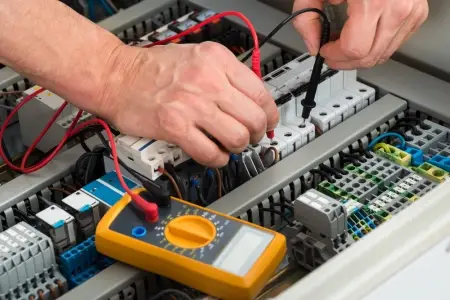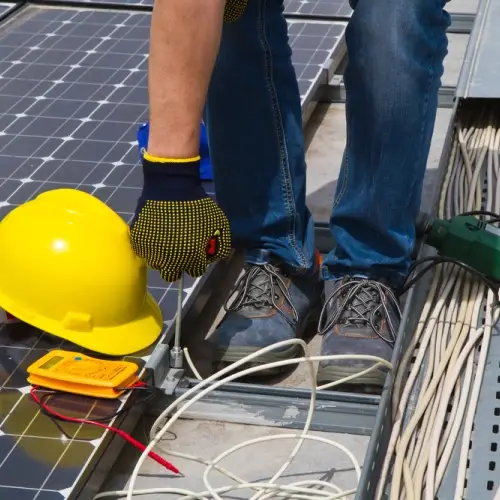
Electric current is one of the fundamental concepts in the study of electricity and electronics. Measured in amperes (A), current intensity represents the amount of electric charge that flows through a conductor in a given time.
Below I show you some examples of electric current intensities in various applications, from household appliances to renewable energy sources and electric vehicles so that you can familiarize yourself with the diversity of magnitudes that this may entail.
Example 1: Household appliances
 Home appliances are an integral part of our daily lives. From cooking to entertainment, these devices use different intensities of electrical current to operate effectively.
Home appliances are an integral part of our daily lives. From cooking to entertainment, these devices use different intensities of electrical current to operate effectively.
Here are some examples:
- Televisions : A typical television consumes between 0.5 A and 3 A, depending on its size and technology. For example, a 50-inch LED TV may consume around 1 A, while an older plasma model could consume up to 3 A. This translates into a power consumption that varies from 50 to 300 W, depending on the efficiency of the model.
- Refrigerators : Refrigerators are another appliance that consumes a significant amount of electrical current. A standard model can consume between 0.5 A and 2 A. With these values, during operation, a refrigerator could use between 60 W and 400 W, depending on its size and energy efficiency.
- Lighting : Lighting also comes in a variety of current intensities. For example, a 10W LED bulb, operating at 230V, consumes approximately 0.043A. In contrast, a 60W incandescent bulb consumes around 0.26A. This difference in consumption highlights the importance of energy efficiency in the home.
- Kitchen mixers : Like most appliances, this one has a universal motor with a typical consumption of between 2 A and 6 A, depending on its power and design. For example, a 500 W mixer would operate at approximately 2.17 A on a voltage of 230 V, while a more powerful 1,000 W model could consume up to 4.35 A.
Example 2: Electronic charges
Electronic loads, including charging devices and computers, also use different current intensities:
- Mobile Phone Chargers: Mobile phone chargers typically have outputs ranging from 1A to 2A. This means that according to Ohm's law a typical charger can charge a phone in a reasonable time, using between 5W and 10W, depending on the output voltage.
- Laptops : A laptop can consume between 1A and 4A, which translates to a range of 15W to 100W, depending on the model and workload.
Example 3: Renewable energy
 Renewable energy is revolutionizing the way we produce and consume energy. Current intensities in these applications can vary widely.
Renewable energy is revolutionizing the way we produce and consume energy. Current intensities in these applications can vary widely.
- Photovoltaic panels : Photovoltaic panels, which convert sunlight into electricity, can generate currents ranging from 5 A to 10 A, depending on the power of the panel. For example, a 300 W panel at 60 V can generate approximately 5 A. In a home solar power system, the current generated can reach between 10 A and 30 A or more, depending on the size of the system and light conditions.
- Wind turbines : Wind turbines in wind farms also have significant variations in current intensity. Small models for residential use can generate currents between 5 A and 15 A. On the other hand, large-scale wind turbines can produce currents of 100 A to 500 A or more, depending on their capacity. For example, a 2 MW wind turbine can generate currents in excess of 400 A at full load.
- Nuclear Power Plants : Nuclear power plants are an important source of energy in many countries. The current intensity generated by these facilities can be extremely high. For example, a 1,000 MW nuclear plant can generate currents of several thousand amperes on its transmission lines, depending on the system voltage, which typically ranges from 500 kV to 750 kV.
Example 4: Electric vehicles
 Electric vehicles are gaining popularity as society looks for more sustainable alternatives to conventional transport. The current intensity in electric vehicles varies depending on the type of charge and the battery capacity.
Electric vehicles are gaining popularity as society looks for more sustainable alternatives to conventional transport. The current intensity in electric vehicles varies depending on the type of charge and the battery capacity.
- Electric Vehicle Batteries : An electric vehicle can have a battery that supports a charging current of between 40A and 150A, depending on the battery capacity and the charger used. By using a Level 2 charger, an electric vehicle can be recharged in a relatively short time.
- Fast chargers : Fast chargers for electric vehicles are capable of operating at currents up to 400 A or more. This capability allows for high-speed charging in a short period of time. For example, a 350 kW charger can charge an electric vehicle in less than an hour, depending on the battery capacity.
Example 5: Industrial applications
Industrial applications also require a clear understanding of electrical current intensities, especially in the operation of heavy machinery.
- Electric motors : Electric motors in industrial applications can draw anywhere from 5A to hundreds of amps, depending on the motor's power rating. For example, a 10 HP motor may draw around 30A at 230V, while a 100 HP motor may draw over 300A.
- Welding processes : In this case, welding processes also use high currents. A MIG welder, for example, can operate at currents between 50 A and 200 A, depending on the type of weld and the thickness of the material. This high current intensity is necessary to melt the metal effectively.
Example 6: Natural phenomena
 Some natural phenomena are one of the electrical phenomena that generate a very high current intensity. Here are some examples:
Some natural phenomena are one of the electrical phenomena that generate a very high current intensity. Here are some examples:
- Lightning : Lightning is a natural electrical discharge that occurs during storms. The intensity of a lightning current can vary between 10,000 A and 200,000 A, which is thousands of times the current consumed by an average home in one day. This discharge can cause significant damage and is a sign of the powerful electrical energy present in nature.
- Static electricity : Static electricity is another natural phenomenon where the build-up of electrical charges on an object can cause a small shock. The current intensity in a static discharge can be very low, typically in the microampere (μA) range, but it can cause surprises, such as the "shock" we feel when touching a metal object after walking on a carpet.